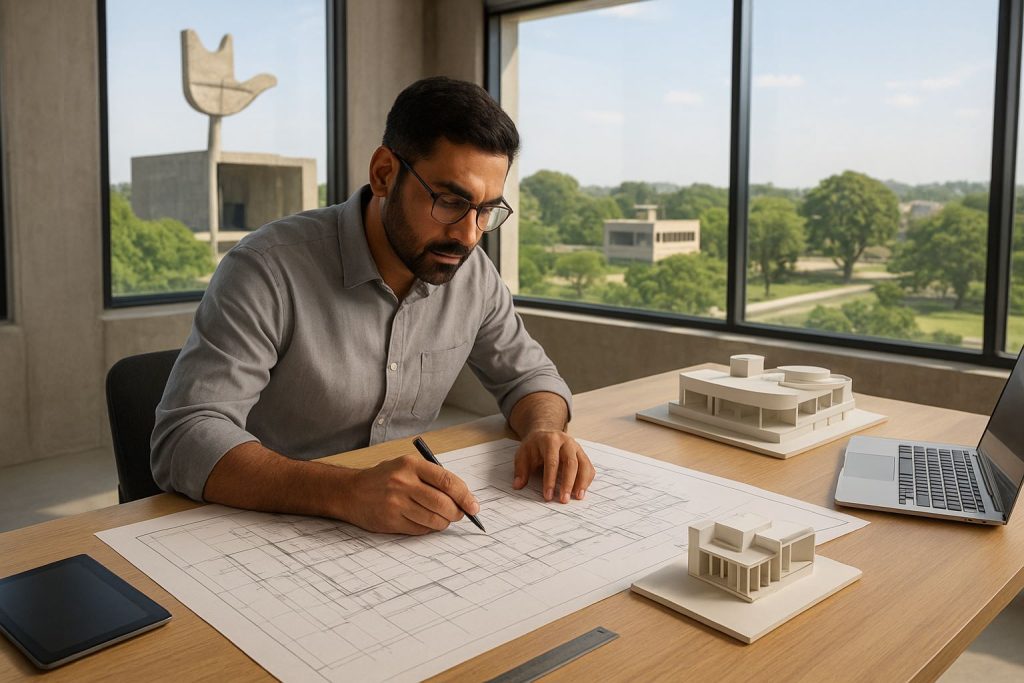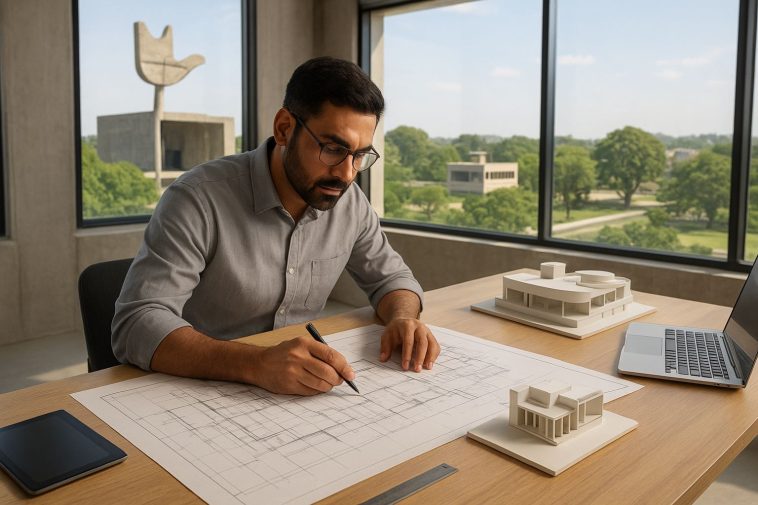Chandigarh, India’s first planned city, stands as a testament to modernist architecture and urban planning. Commissioned in 1950 by India’s first Prime Minister, Jawaharlal Nehru, the city was envisioned as a symbol of India’s post-independence aspirations.
The architectural mastermind behind this ambitious project was the Swiss-French architect Le Corbusier.
However, his cousin and collaborator, Pierre Jeanneret, played a pivotal role in bringing the vision to life.

The Genesis of Chandigarh
Following the partition of India in 1947, the state of Punjab was left without a capital. To address this, Nehru envisioned a new city that would embody modernity, progress, and a break from colonial pasts.
In 1950, he invited Le Corbusier to design the city’s master plan. The only brief given was to create a city that was “expressive, experimental, and not to be hindered by tradition.”
Le Corbusier accepted the challenge and began work on what would become one of his most iconic projects.
Le Corbusier: The Visionary Architect
Charles-Édouard Jeanneret-Gris, known professionally as Le Corbusier, was born in 1887 in La Chaux-de-Fonds, Switzerland.
A pioneer of modern architecture, he believed in the power of design to shape society. His architectural philosophy emphasized functionality, simplicity, and the use of modern materials.
Le Corbusier’s design for Chandigarh reflected these principles, featuring a grid-based layout, expansive green spaces, and monumental concrete structures.
Pierre Jeanneret: The Unsung Hero
While Le Corbusier was the face of the Chandigarh project, Pierre Jeanneret’s contributions were equally significant. Born in 1896 in Geneva, Switzerland, Jeanneret was Le Corbusier’s cousin and long-time collaborator.
In 1951, he moved to India to assist with the Chandigarh project. Jeanneret’s deep understanding of local contexts, materials, and climate allowed him to adapt modernist principles to the Indian setting.
He designed numerous buildings in Chandigarh, including the Gandhi Bhawan at Punjab University and the M.L.A. Hostels. His work seamlessly blended modernist aesthetics with local traditions, creating structures that were both functional and culturally resonant.
The Collaborative Effort
The success of Chandigarh was not solely due to Le Corbusier’s vision but also to the collaborative efforts of several architects and planners.
British architects Maxwell Fry and Jane Drew played crucial roles in designing climate-responsive buildings and integrating local architectural elements.
Indian architects like Bhanu Pratap Mathur and Jugal Kishore Chowdhary contributed significantly to the city’s development. Together, this diverse team transformed a barren landscape into a thriving urban center.
Architectural Highlights of Chandigarh
1. Capitol Complex
At the heart of Chandigarh lies the Capitol Complex, a monumental ensemble of government buildings. Designed by Le Corbusier, it includes the Secretariat, the High Court, and the Palace of Assembly.
These structures are characterized by their massive concrete forms, open spaces, and symbolic sculptures, reflecting the power and authority of the state.
2. Sectoral Planning
Chandigarh’s urban design is based on a sectoral layout, with each sector functioning as a self-contained unit. This planning approach ensures efficient land use, easy navigation, and a balance between residential, commercial, and recreational spaces.
The sectors are connected by wide boulevards and green belts, promoting a harmonious urban environment.
3. Open Hand Monument
One of the most iconic symbols of Chandigarh is the Open Hand Monument, designed by Le Corbusier. Standing tall in the Capitol Complex, the monument signifies “open to give, open to receive.” It embodies the city’s ethos of peace, unity, and progress.
4. Sukhna Lake
Artificially created by damming the Sukhna Choe, Sukhna Lake is a man-made reservoir that adds to the city’s charm. It serves as a recreational area for residents and visitors, offering boating facilities and scenic views.
Pierre Jeanneret’s Legacy
Pierre Jeanneret’s contributions to Chandigarh extend beyond architecture. He was instrumental in designing the city’s furniture, including the now-iconic teak-and-cane chairs.
These pieces, once ubiquitous in government buildings, have gained international acclaim for their minimalist design and craftsmanship. Today, they are sought after by collectors and designers worldwide.
In recognition of his efforts, the Chandigarh Administration has restored Jeanneret’s residence, House No. 57 in Sector 5, and converted it into a museum.
The museum showcases his architectural drawings, photographs, and personal artifacts, preserving his legacy for future generations.
Conclusion
Chandigarh stands as a monumental achievement in modern architecture and urban planning. While Le Corbusier’s vision laid the foundation, it was the collaborative efforts of architects like Pierre Jeanneret and others that brought the city to life.
Their work continues to inspire architects and urban planners, demonstrating the power of design to shape society and culture.
FAQs
Q1: What was the primary architectural style of Chandigarh?
Chandigarh predominantly features modernist architecture, characterized by clean lines, functional design, and the use of concrete and steel.
Q2: Who were the key architects involved in the Chandigarh project?
The project was led by Le Corbusier, with significant contributions from Pierre Jeanneret, Maxwell Fry, Jane Drew, and several Indian architects.
Q3: What is the significance of the Open Hand Monument?
The Open Hand Monument symbolizes peace, unity, and the philosophy of “open to give, open to receive,” reflecting the city’s ethos.
Q4: Where can I learn more about Pierre Jeanneret’s work?
The Pierre Jeanneret Museum in Chandigarh offers insights into his architectural contributions and personal artifacts.
Q5: Are the furniture pieces designed by Pierre Jeanneret still available?
Yes, original pieces are now considered collectibles and can be found in select antique stores and auctions worldwide.


